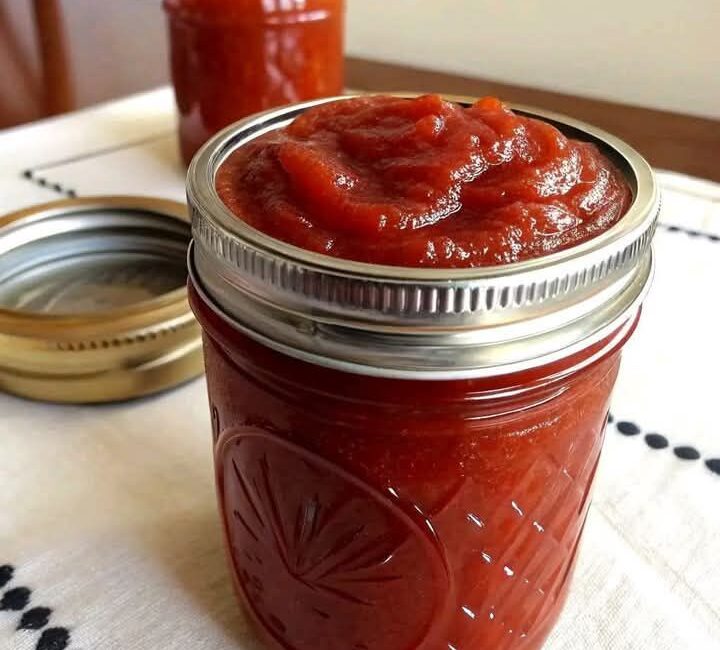Introduction
There’s something deeply satisfying about making homemade canned ketchup from scratch. Unlike store-bought versions, this homemade ketchup is bursting with natural tomato flavor, free from preservatives, and customizable to your taste.
By canning your ketchup, you can enjoy its rich, tangy goodness year-round, perfect for pairing with fries, burgers, hot dogs, or even as a base for BBQ sauces. This guide will walk you through everything you need to know, from selecting the best tomatoes to mastering the canning process for long-lasting storage.
So, let’s dive in and create the best homemade ketchup you’ve ever tasted! 🍅🔥
Why Make Homemade Ketchup?
✔ 100% Natural Ingredients – No high-fructose corn syrup, preservatives, or artificial flavors.
✔ Customizable Spice Blend – Adjust the sweetness, tanginess, and heat to suit your preference.
✔ Long Shelf Life – Canned ketchup can last up to 12 months when properly sealed.
✔ Rich, Thick Texture – No watery ketchup here! Slow cooking gives it a deep, flavorful consistency.
✔ Perfect for Gifting – Impress friends and family with homemade jars of gourmet ketchup.
Ingredients for the Best Homemade Canned Ketchup
This classic homemade ketchup recipe combines ripe tomatoes, tangy vinegar, and warm spices to create a perfectly balanced condiment.
Main Ingredients:
- 12 lbs ripe tomatoes, cored and quartered – Fresh, juicy tomatoes are key to deep flavor.
- 2 cups chopped onions – Adds sweetness and depth.
- 1 ½ cups apple cider vinegar – Gives the ketchup its signature tang.
- 1 cup packed brown sugar – Provides natural sweetness and a hint of molasses.
- 1 tablespoon salt – Enhances all the flavors.
Spices for Classic Ketchup Flavor:
- 1 teaspoon ground allspice – Warm, aromatic, and slightly sweet.
- 1 teaspoon cinnamon – Adds subtle depth.
- 1 teaspoon mustard powder – Gives a mild tangy kick.
- ½ teaspoon ground cloves – Infuses a hint of warmth.
- ½ teaspoon cayenne pepper – Just the right amount of heat.
Step-by-Step Guide to Making Homemade Canned Ketchup
Step 1: Prepare the Tomatoes
- Wash and Core: Rinse the tomatoes thoroughly and remove the cores.
- Chop into Quarters: This makes them easier to cook down.
- Cook Until Soft: In a large non-reactive pot, combine tomatoes and chopped onions.
- Simmer for 30 Minutes: Stir occasionally until the tomatoes break down and release their juices.
⭐ Pro Tip: Use Roma or San Marzano tomatoes for the best thick texture.
Step 2: Blend & Strain for Smooth Texture
- Blend the Mixture: Use a blender or immersion blender to puree the tomatoes and onions until smooth.
- Strain to Remove Seeds & Skins:
- Use a fine-mesh sieve or food mill.
- Press the puree through to extract every drop of liquid.
- Discard Seeds & Skins: This leaves you with a silky smooth ketchup base.
⭐ Pro Tip: Straining makes the ketchup thicker and smoother—don’t skip this step!
Step 3: Simmer & Season
- Return the strained puree to the pot.
- Add apple cider vinegar, brown sugar, salt, and all spices.
- Bring to a boil, then reduce heat to a gentle simmer.
- Stir occasionally and simmer for 2-3 hours, until the ketchup thickens.
⭐ Pro Tip: The longer it simmers, the richer and thicker it becomes.
Step 4: Can the Ketchup for Long-Term Storage
- Sterilize Jars:
- Boil mason jars in hot water for 10 minutes to kill bacteria.
- Place lids and bands in hot (not boiling) water to soften the seal.
- Ladle the Hot Ketchup into Jars:
- Leave ½ inch headspace at the top.
- Wipe rims with a damp cloth to ensure a tight seal.
- Seal & Process in a Water Bath:
- Place jars in a boiling water bath for 15 minutes.
- Cool Completely:
- Remove jars carefully and place them on a towel.
- Let them sit undisturbed for 24 hours.
⭐ Pro Tip: Check seals by pressing on the lid—if it doesn’t pop, it’s sealed correctly!
How to Store & Use Your Homemade Ketchup
Storage Instructions:
✔ Store sealed jars in a cool, dark place for up to 12 months.
✔ Refrigerate after opening and use within 4-6 weeks.
Ways to Use Your Homemade Ketchup:
🍔 Classic Condiment – Perfect for burgers, hot dogs, and sandwiches.
🍟 Dipping Sauce – Pair with fries, onion rings, or chicken tenders.
🥩 Marinade & BBQ Base – Adds deep flavor to meats.
🥗 Salad Dressing Base – Mix with olive oil and vinegar for a tangy dressing.
🥘 Cooking Ingredient – Use in soups, stews, and chili for added richness.
Tips & Tricks for the Best Homemade Ketchup
🔥 Use Vine-Ripened Tomatoes – They have the best natural sweetness and flavor.
🔥 Balance Sweetness & Tang – Adjust brown sugar or vinegar to taste.
🔥 Simmer for Depth – The longer you cook, the richer the flavor.
🔥 Use a Non-Reactive Pot – Stainless steel or enamel prevents acidity reactions.
🔥 Experiment with Spices – Try paprika, garlic powder, or smoked salt for unique flavors.
Frequently Asked Questions (FAQs)
1. Can I Make This Ketchup Without Sugar?
Yes! Substitute honey, maple syrup, or a sugar-free sweetener for a healthier version.
2. How Do I Make Spicy Ketchup?
Add extra cayenne pepper, chipotle powder, or fresh jalapeños for heat.
3. Can I Freeze This Ketchup Instead of Canning?
Absolutely! Store in airtight containers and freeze for up to 6 months.
4. How Do I Know If My Canned Ketchup is Still Good?
Check for spoiled smells, mold, or bulging lids—if in doubt, throw it out!
5. Can I Use This Recipe for Other Canned Sauces?
Yes! Adjust the spices for BBQ sauce, pasta sauce, or curry ketchup.
Conclusion – The Best Homemade Ketchup You’ll Ever Make!
Making your own canned ketchup is fun, easy, and incredibly rewarding. With its rich tomato flavor, perfect blend of spices, and long shelf life, you’ll never want to go back to store-bought ketchup again!
🔥 Why not try it today? Your fries, burgers, and sandwiches will thank you!
🍅 Love homemade recipes? Let me know in the comments so I can keep sharing more with you!




